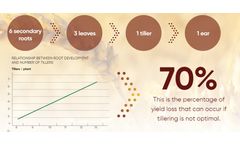wheat growth Articles
-
Sensitivity analysis of the CERES-wheat model for variations in CO2 and meteorological factors in Northwest Turkey
Plant growth is very sensitive to variations in atmospheric factors. Possible effects of climate change on plant growth can be estimated and evaluated using the crop growth simulation models. In this study, the CERES (Crop Environment Resource Synthesis)-wheat model was applied to two consequent growing seasons (1997–1998 and 1998–1999) in order to determine the model sensitivity on the changes ...
-
Comparison of in situ DGT measurement with ex situ methods for predicting cadmium bioavailability in soils with combined pollution to biotas
To assess the capabilities of the different techniques in predicting Cadmium (Cd) bioavailability in Cd-contaminated soils with the addition of Zn, one in situ technique (diffusive gradients in thin films; DGT) was compared with soil solution concentration and four widely used single-step extraction methods (acetic acid, EDTA, sodium acetate and CaCl2). Wheat and maize were selected as tested ...
-
2014 Soyabean Trial - Case Study
Results of studies carried out under growth room conditions indicated that Hibrix soil amendment can provide significant increases in the growth of wheat, soybean and canola.?In the summer of 2013, a field trial was conducted using soybeans as the indicator crop to test the effectiveness of Hibrix soil amendment for increasing plant growth and productivity under field conditions. The trial was ...
-
Phytotoxic effect of aluminum and chromium on the germination and early growth of wheat (Triticum aestivum) varieties Anmol and Kiran
A greenhouse experiment was conducted to determine the phytotoxic effect of aluminum and chromium on the germination and early growth of two wheat (Triticum aestivum) varieties Anmol and Kiran. Seed were treated with 40, 80, 120 and 160 ppm of aluminum and chromium solution individually and in combined form. Observations were made on seed germination, root, shoot and seedling length, and dry ...
-
Aerial color infrared photography to optimize in-season nitrogen fertilizer recommendations in winter wheat
Remote sensing in the form of aerial color infrared (CIR) photography has been shown to be a useful tool for in-season N management in winter wheat (Triticum aestivum L.). The objectives of this study were (i) to develop a methodology for predicting in-season optimum fertilizer N rates for winter wheat at growth stage (GS) 30 directly from aerial CIR photography and (ii) to quantify how the ...
-
Wheat: Preparing the Root System for Tillering and Vegetative Growth
The number of tillers is the primary yield component of straw cereals, including wheat, the world’s most widely grown cereal. The number of tillers is fundamental to crop yield development. It will compensate for the loss of plants during sowing due to poor planting. It is directly related to the final number of ears. Three leaves constitute a tiller, and this tiller can be transformed ...
-
Providing Tailored Crop Recipes, So Clients Can Hit the Ground Running
“You could best divide our products and services into three parts, being: external research and in-house contract research in our R&D labs, providing total indoor farming solutions, and collaborating in research projects,” explains Maarten Vandecruys, co-founder and CTO at Urban Crop Solutions ...
-
Inhibition of seed germination and seedling growth of Triticum aestivum L. by industrial wastewaters
The present study was undertaken to determine the effect of different concentrations of wastewaters treated with Pseudomonas putida on various growth indices of durum wheat (Triticum aestivum L.) seeds. Significant decreases in terms of root and leaf growth were observed. The phytotoxicity of textile wastewater was more pronounced on initiation times, germination percentages, root and leaf ...
-
An Instrumented Rhizotron to Investigate the Root Growth In Wheat - Case Study
There has been much recent interest in modifying root system properties to overcome the effects of soil abiotic stress on crop growth and yield (Lynch 2007; Ghanem et al. 2011). Plant root systems are usually exposed to heterogeneous environmental conditions due to vertical differences in soil moisture and strength. Strong subsurface layers of soil can confine root systems to shallower soil ...
-
A root-zone soil regime of wheat: physiological and growth responses to furrow irrigation in raised bed planting in northern China
Different irrigation methods in wheat (Triticum aestivum L.) result in different water and nutrient use efficiencies and, ultimately, plant growth. A field experiment was conducted during the 2006–2007 and 2007–2008 crop cycles to investigate the effects of furrow irrigated raised bed planting and the effects of flood irrigated conventional planting on growth and productivity in winter wheat. In ...
-
Variation in characteristics and imazamox tolerance of feral rye
Rye (Secale cereale L.) is a minor crop in America, with similarities to wheat (Triticum aestivum L.) in growth habit and distribution. However, feral rye has become a weed in wheat. Little is known about variation in feral rye morphological characteristics that influence success of cultural controls. Thus, 21 feral rye populations were sampled from wheat fields in central Oklahoma to ...
-
Effect of exo-polysaccharides producing bacterial inoculation on growth of roots of wheat (Triticum aestivum L.) plants grown in a salt-affected soil
Abstract: Effect of soil salinity on physico-chemical and biological properties renders the salt-affected soils unsuitable for soil microbial processes and growth of the crop plants. Soil aggregation around roots of the plants is a function of the bacterial exo-polysaccharides (EPS), however, such a role of the EPS-producing bacteria in the saline environments has rarely been investigated. Pot ...
-
Cattle gain and crop yield for a dryland wheat-sorghum-fallow rotation
Increasing pumping costs and declining well capacities in the U.S. Southern High Plains have led to greater reliance on less productive and inherently riskier dryland cropping systems. Dryland wheat (Triticum aestivum L.) and grain sorghum [Sorghum bicolor (L.) Moench] are typically grown in a 3-yr wheat-sorghum-fallow (WSF) rotation that may be intensified by integrating cattle (Bos taurus) ...
-
Ancient roots of wheat virus resistance
The DNA sequence of a gene responsible for resistance to a devastating virus in wheat has been discovered, providing important clues for managing more resistant crops and maintaining a healthy food supply. Wheat crops in the Americas, Asia, Europe, and Africa are regularly damaged by wheat yellow mosaic virus (WYMV), and there is a high demand for wheat varieties or cultivars that are resistant ...
By Lifeasible
-
Moving Up the Food Chain
For most of the time that human beings have walked the earth, we lived as hunter-gatherers. The share of the human diet that came from hunting versus gathering varied with geographic location, hunting skills, and the season of the year. During the northern hemisphere winter, for instance, when there was little food to gather, people there depended heavily on hunting for survival. Our long history ...
Need help finding the right suppliers? Try XPRT Sourcing. Let the XPRTs do the work for you





